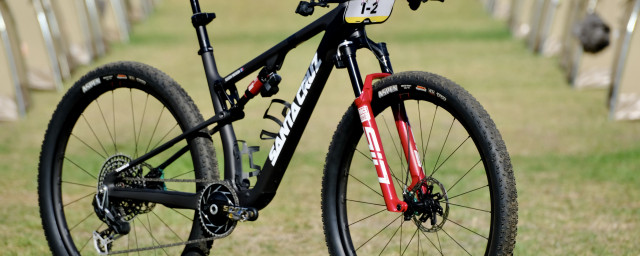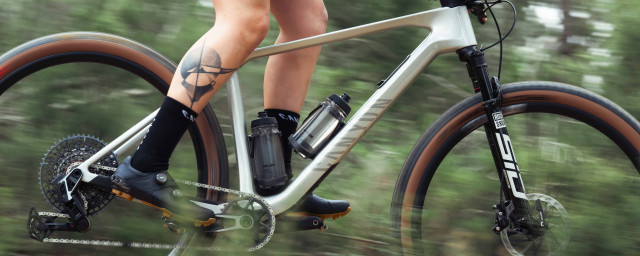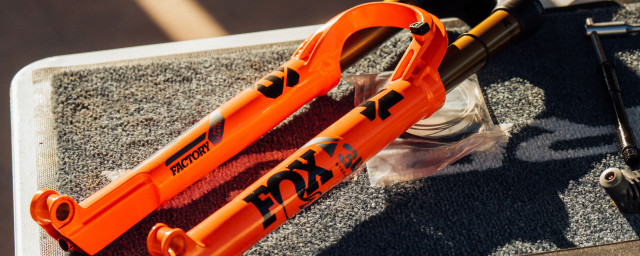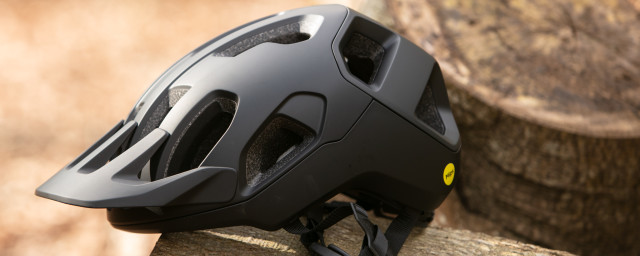Your complete guide to the 2024 Fox suspension fork range from the 32 Step Cast to the 40

With many a podium under its belt, the signature gold of Fox's Kashima-coated suspension forks is synonymous with mountain biking. Now the brand has a rich portfolio of forks built for every application from gravel to downhill. In 2024, Fox updated its range with a new 32 Step-Cast for cross-country riding and introduced a fresh selection of dampers. Here, we'll dissect each fork to tell you exactly what each one is all about.
- How to set up your mountain bike suspension
- 9 tips to keep your suspension running sweeter for longer
- Busting those suspension myths with Fox
The differences between Performance, Performance Elite and Factory
Almost all the forks and rear shocks in Fox's range of suspension components are available in three models, Performance, Performance Elite, and Factory. The former is the base-level fork that gets the most basic of Fox's technologies whereas Factory forks get all the bells and whistles.
Performance forks get the GRIP damper, black anodised stanchions, and a three-position compression adjustment lever/lockout. On some models, the Performance forks get a 15QR axle instead of a Kabolt X fixing.
Performance Elite forks benefit from a more sophisticated GRIP X damper with high-speed and low-speed compression adjustments and low-speed rebound. Like the Performance level, Performance Elite runs black anodised stanchions but gets a Kabolt axle. The Fox 38 Performance Elite uses the GRIP X2 damper that's more descent-focused and comes with a high-speed rebound adjustment.
Fox's Factory level forks is the top-end of the range. These forks are built with Kashima coatings and get the most sophisticated GRIP X2 on the trail and enduro forks or GRIP SL dampers on the cross-country models.
Fox suspension forks
Fox Taper-Cast
The Taper-Cast is Fox's gravel-specific suspension fork and the brand goes as far as to say that it's the lightest fork it's ever created. Being built for gravel applications, it is the first fork to bring in a reverse arch that's been added to improve fitment and aerodynamics while providing stiffness. This fork also gets its own crown profile and dial shapes in a bid towards downtube clearance. Other hardware includes the Kabolt thru-axle and the fork can accommodate flat-mount brakes with a 160mm or 180mm rotor.
With clearance for up to a 700c x 50mm tyre, the Taper-Cast isn't designed to work with 650b wheels. It then gets an axle-to-crown measurement of 435.5mm. It then uses Fox's Float EVOL air spring, a 1.5in tapered steerer tube and fender mount hardware is included in the box.
The Fox Taper-Cast Factory comes with Kashima-coated stanchions and Fox's Grip SL damper and it is set to weigh 1,161g. This fork is available with 40mm or 50mm of travel. The latter stretches the axle-to-crown to 445.5mm.
The Fox Taper Cast Performance gets the simpler GRIP damper, and black anodised stanchions and is claimed to weigh 1,226g. It also comes with 40mm of travel.
Fox 32 Step-Cast
The Fox 32 Step-Cast is the very latest fork from the brand and it's said that this fork is designed for marathon racing and those who prioritise lightweight. Like the Taper-Cast, the 32 Step-Cast gets a reverse crown to up stiffness by a claimed 40 per cent without impacting weight. This reverse arch will clear all cross-country bike frames. It uses Fox's Kabolt SL axle, which saves 12g by ditching the axle nut and making the flange smaller. As its name suggests, it gets 32mm diameter stanchions.
Complimenting the rearward arch is a newly redesigned crown is built from 7000 Series aluminium. It's a zero offset crown that angles the stanchions rather than using more material to achieve the fork's 44m rake. Fox says the crown drops around 20g over the previous 32 forks.
The Fox 32 Step-Cast is available in two builds with the Factory benefitting from the GRIP SL three-position or two-position remote dampers. It's only available with 100mm of travel and for 29-inch wheels. As a Factory model, it gets Kashima-coated stanchions, it can then accommodate 160mm rotors with a post-mount caliper bolted directly to the fork or a 180mm rotor with an adapter. The fork runs on a Float EVOL air spring.
The Performance level fork uses black anodised stanchions and the GRIP damper in either three-position or two-position remote options.
The starting weight for the 32 Step-Cast Factory is a claimed 1,276g whereas the Performance's weight is not stated.
Fox 34 Step-Cast
The 34 Step-Cast is Fox's 34mm stanchioned fork that balances light weight and strength for cross-country racing. Unlike the small stanchioned forks that come before it, the 34 Step-Casts is a more traditional forward-facing affair but it's placed more forward of the fork to provide headtube clearance when the fork's at the bottom out. It's been diligently designed to optimise stiffness while using as little material as possible to save those grams. Similarly to the 32 Step-Cast, the 34 variant comes with the Kabolt SL axle.
This fork can be picked up in Factory and Performance builds with the former getting all of that Factory goodness, including Kashima stanchions and it's available in 100 or 120mm travel options as well as 44 and 51mm rakes. The Fox 34 Step-Cast can accommodate a 160mm rotor with the brake caliper bolted directly to the fork. It can host up to a 180mm rotor with an adapter. It also comes with a 1.5in tapered steerer. As a Factory build, the 34 Step-Cast Factory dons the GRIP SL three-position and two-position remote dampers. It's also 29in wheel only.
The Performance model gets a lot of what's found on the Factory build but gets black anodised stanchions and a GRIP three-position damper. Another difference is that this fork is only available with 120mm of travel.
Fox 34
The Fox 34 packages the 34mm stanchions of the 34 Step-Cast in a slightly different chassis and kits it with more trail-friendly technologies. It gets a similar lower leg arch but notably, the Fox 34 ditches the step in the lowers. Speaking of the lower, it also ushers in lower leg bypass channels which addresses the issue of air pressure increasing as the fork compresses by increasing the air volume inside the lower legs. Fox says that this reduces the unintended ramp-up of the air pressure. These channels also help circulate the lower bath oil better, keeping the fork thoroughly lubricated.
With the 34, customers can also pick from a greater range and it introduces the GRIP X damper which is intended to perform on the descents.
The Fox 34 Factory boasts Kashima stanchions, the GRIP X damper and a Float EVOL air spring. It can accommodate a 180mm rotor with the caliper mounted directly to the fork but run up to a 203mm rotor with an adapter. It's only compatible with 29-inch wheels and 140 and 130mm travel options. There's also a 1.5in tapered steerer tube, a Kabolt axle and 44mm rake.
The Performance Elite fork gets everything found in the Factory but trades the Kashima stanchions for anodised black tubes. It's also only available with 130mm of travel.
The Fox 34 Performance is damped by a GRIP damper and comes with 140mm of travel. This one gets a 15QR x 110 axle instead of the Kabolt.
Claimed weights are 1,686g for each fork in the range.
Fox 36
The enduro fork now takes up all-mountain duties with its 36mm stanchions. It's also the smallest stanchion fork to bring the gravity-focused GRIP X2 damper. Like many of Fox's other forks, the brand has paid attention to the 36's lower leg arch to shave grams but up stiffness. The 36 also introduces Lower Leg Bleeders and the Lower Leg Bypass Channels. The Bleeders allow riders to equalise the fork's internal pressure with atmospheric pressure by pressing on each bleeder. The Lower Leg Bypass channels increase the fork's volume to alleviate pressure ramping as the fork compresses.
As well as those, the 36 gets a burlier Kabolt X bolt-on floating axle. What's special here is that it increases torsional stiffness thanks to a sleeveless design with a single pinch bolt. This helps align the chassis to reduce friction, retaining smooth suspension travel. However, this fork can be picked up with a quick-release floating axle.
This one comes in Factory, Performance Elite and Performance build with the former getting that GRIP X2 damper and the Float EVOL air spring. Available in 160 and 150mm of travel, the Fox 36 Factory is equipped with Kashima-coated stanchions, Kabolt X, and a 1.5in tapered steerer. This fork can accommodate a 180mm rotor with the caliper bolted directly to the fork but can rock a 230mm rotor with adapters. There's also a 44mm rake.
The Performance Elite model ditches Kashima in favour of black anodised stanchions. Otherwise, it's sorted with all of the good stuff of the Factory fork but it is only available with 160mm of squish.
The Performance fork omits some more major features while opting for a GRIP damper. Those features left behind are the Lower Leg Bleed Ports and the Kabolt X floating axle. Everything else matches the Performance Elite fork.
Claimed weights are 1,929g across the board.
Fox 36E
The Fox 36E is, for the most part, the same as the 36 but optimised for use on e-mountain bikes. It's available in 160mm of travel and gets the same gubbins as the Fox 36 Factory. However, there is a GRIP X option alongside the GRIP X2 damper. This fork is only available in the Factory guise.
Starting weight is 1,929g.
Fox 38
The 38 is all about long travel and enduro with its large 38mm stanchions. Along with its fat tubes, it boasts a light but stiff lower leg arch to support a lot of travel through gnarly terrain. Like the 36, this fork boasts Lower Leg Bleeders, Bypass Channels and the Kabolt X axle.
This fork is available in Factory and Performance Elite guises with Factory, of course, getting Kashima stanchions a GRIP X2 damper and EVOL air spring. It can accommodate up to a 230mm rotor, comes with a 1.5in tapered steerer and can be picked up in 160 up to 180mm of suspension travel. There's then a rake of 44mm and this fork can be bought to work with either 29 or 650b wheels.
The Performance Elite fork gets all of what's seen on the Factory model but it is only available for 29-inch wheels and in 170mm of travel.
The claimed weight for both forks is 2,194g.
Fox 40
The Fox 40 is the brand's dual-crown downhill fork with 40mm stanchions. It gets the technologies found on the smaller forks, including the Lower Leg Bleeders, Lower Leg Channels and Fox's refinements to the lower leg arch. This one then gets a floating thru-axle with two pairs of bolts for extra stiffness and security.
Fox's downhill fork is only available in a Factory build that benefits from the new GRIP X2 damper. It can be bought in models to fit 29 and 650b wheels with 48 and 52mm rakes. It dons 203mm of suspension travel, can fit up to a 230mm brake rotor, gets the Kashima coating and a 1.125in straight steerer.
The claimed weight for the Fox 40 Factory is 2,745g.
Fox AWL
Last up is the Fox AWL, which stands for Adventure Without Limits. This is an E-SUV fork, so it's designed to cope with the serious weight of utility e-MTBs. The AWL can suit a variety of riding, whether that's those who ride hybrid e-bikes or those who haul serious cargo. It comes in two models with both being able to carry 165kg of weight and it's sorted with fender and rack mounts.
Fox's AWL fork comes in two models, the regular AWL and the AWL HD with the former rocking 34mm stanchions with 100mm of travel. It's available in 29in and 650b sizes, it gets black anodised stanchions, can run up to a 230mm brake rotor and uses a 1.5 tapered steerer. There's also a 44mm rake and it runs on a RAIL damper.
The AWL HD beefs things up even more with 36mm stanchions and 140 or 150mm of travel. It gets all of the features seen on the regular AWL.
Fox claims a weight of 2,135 for the AWL HD. Note - The FOX AWL and AWL HD aren't available to the UK market.
Fox fork technologies
Fox has some technologies that it uses exclusively on its forks.
-
GRIP X2: The GRIP X2 damper is focused towards descending performance and it boasts the most tuneability of all of Fox's damper lineup featuring eight clicks of high-speed compression, 18 clicks of low-speed compression, eight clicks of high-speed rebound, and 16 clicks of low-speed rebound.
-
GRIP X : GRIP X is a damper that balances downhill performance and lightweight in a package that's easier to set up. It benefits from 15 clicks of high-speed compression, 16 clicks of low-speed compression, and 17 clicks of low-speed rebound. There is no high-speed rebound adjustment on this damper.
-
GRIP SL: This is Fox's lightweight damper that's built for the brand's shorter travel forks. As well as optimising pedal-to-bump efficiency, it's built with a blow-off valve that enables the fork to move through its travel under harder impacts even when locked out. This damper provides three on-the-fly compression damping settings, Open, Firm and Medium. There are 17 clicks of low-speed rebound. It's also available in an option that offers two on-the-fly compression positions, Open and Firm.
-
GRIP: The GRIP damper is Fox's most basic unit that comes sorted with pressure balancing tech to improve damping performance while using the spring-backed internal floating piston. GRIP comes with Open, Medium and Firm compression settings and 10 clicks of low-speed rebound.
-
Float EVOL air spring: Fox's air spring system that is used across the entire range. The EVOL part stands for 'Extra VOLume' and indicates that it has a larger negative air spring than previous Float designs to make the initial part of the travel more linear.
-
Kabolt X axle: This can be used to replace the standard flip-lever 15mm through axle found on Fox forks. It's lighter than standard but requires a 6mm Allen key to undo.
-
Kabolt SL: Kabolt SL is a thru-axle that's employed by Fox's lightweight cross-country forks. This axle provides a 12g weight saving over the standard Kabolt axle by binning the axle nut and shaving material from the flange.
-
Kashima Coat: This is a hard anodising surface treatment created by Miyaka Company of Japan. It consists of "lubricating molybdenum disulfide deposited via electrical induction into the billions of micro-pores on the surface of hard-anodized aluminium for better lubrication and less abrasion and wear."
-
Lower leg channels: These are seen on the 34, 36, 38 and 40 lower legs and are an air channel that increases the amount of air volume in the lower leg of the fork. As a fork compresses, the air trapped inside the bottom of the lower leg is squashed and this acts like another air spring to the main one, giving a resistance to bottoming out that the rider can't tune, making it hard to get full travel. This greater volume provides less ramp-up effect, meaning the air spring can operate without this interference. It's also allowed them to use a greater volume of lubricating oil in the lower and provides a pathway for that oil to get higher up into the bushings and seals, meaning your fork should stay smoother for longer.
-
Lower Leg Bleeders: Fox's Lower Leg Bleeders are small buttons found at the rear of the fork's lowers just under the seals. When pressed, these equalise pressure that can build up in the fork lowers when riding at high altitudes or when tackling large descents. The result is improved and more consistent fork performance.
-
Volume spacers: All Fox Shox forks allow the user to control how progressive the ending stroke of the fork is by using volume spacers. These require you to undo the top cap of the fork's air spring side leg and then add or remove clip-on spacers. Adding more increases the resistance to bottoming out, while removing them does the opposite. The volume spacers are specific to fork models and colour-coded to match. The thicker legs on E-Bike-specific forks require a spacer from the fork below it; a 36 E-Bike fork would use the spacer for a standard 34 fork, not a standard 36 fork.
-
Variable Valve Control (VVC): VVC is Fox's method of high-speed compression damping that uses an adjustable leaf spring that applies leverage onto a disc that then applies force onto a shim stack. The more force applied to the leaf spring, the more force required to open the shims, thus the more damping you'll receive. Fox says that the benefit of this is that riders can achieve a similar effect to tuning the shim stack but with the ease of an external knob.
- www.ridefox.com

















